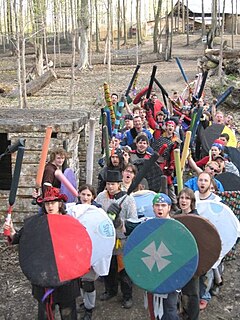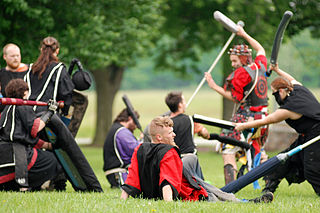
The Society for Creative Anachronism (SCA) is an international living history group with the aim of studying and recreating mainly Medieval European cultures and their histories before the 17th century. A quip often used within the SCA describes it as a group devoted to the Middle Ages "as they ought to have been", choosing to "selectively recreate the culture, choosing elements of the culture that interest and attract us". Founded in 1966, the non-profit educational corporation has over 30,000 paid members as of 2017 with about 60,000 total participants in the society.

Jousting is a martial game or hastilude between two horseriders wielding lances with blunted tips, often as part of a tournament. The primary aim was to replicate a clash of heavy cavalry, with each participant trying hard to strike the opponent while riding towards him at high speed, breaking the lance on the opponent's shield or jousting armour if possible, or unhorsing him. The joust became an iconic characteristic of the knight in Romantic medievalism. The participants experience close to three and a quarter times their body weight in G-forces when the lances collide with their armour.

Plate armour is a historical type of personal body armour made from bronze, iron, or steel plates, culminating in the iconic suit of armour entirely encasing the wearer. Full plate steel armour developed in Europe during the Late Middle Ages, especially in the context of the Hundred Years' War, from the coat of plates worn over mail suits during the 14th century.

The Pennsic War is an annual American medieval camping event held by the Society for Creative Anachronism (SCA), a "war" between two large regional SCA groups: the Kingdom of the East and the Middle Kingdom. It is the single largest annual SCA event, with more than 10,000 people attending each year, from as far as China, South Korea, Sweden, Germany, France, Italy, Greece, and Australia.

Amtgard is a battle gaming and live-action fantasy roleplaying and boffer combat game with chapters primarily based in the United States and Canada as well as Germany, Croatia, and South Korea.

A foam weapon, also known as a boffer, padded weapon, or latex weapon, is a padded mock weapon used for simulated handheld combat. Such weapons are used in simulated battles called battle gaming and in some live action role-playing games (LARPs).

Dagorhir Battle Games is a live action role-playing game local to the Washington, D.C., U.S.A. metropolitan area with full-contact melee fighting and ranged combat as its primary focus. Fighters typically use foam weapons such as swords, flails, spears, bows and arrows, javelins, axes, and other medieval weapons. Participants wear period costume and are expected to stay in-character during events, although the amount of seriousness the role-playing aspect receives varies greatly by unit and chapter.

The West Kingdom is the oldest Kingdom of the historical re-enactment Society, Society for Creative Anachronism. It comprises Northern California, Nevada, Alaska, Japan, Korea and the Pacific Rim.
Codex Belli is the name of a set of rules for medieval combat reenactment first issued in 1999 and then revised by the German umbrella group Kämpferliste in 2002.
Medieval reenactment is a form of historical reenactment that focuses on re-enacting European history in the period from the fall of Rome to about the end of the 15th century. The second half of this period is often called the Middle Ages. This multiplicity of terms is compounded by the variety of other terms used for the period.

Combat reenactment is a side of historical reenactment which aims to depict historical forms of combat. This may refer to either single combat, melees involving small groups, or nearly full-scale battles with hundreds of participants.
Rapier Combat is a style of historical fencing practiced in the Society for Creative Anachronism (SCA). The primary focus is to study, replicate and compete with styles of rapier sword-fighting found in Europe during the Renaissance period, using blunted steel swords and a variety of off-hand defensive items. Participants wear period clothing while competing, along with or incorporating protective equipment for safety. In the April 2020 update of the rules, the sport was renamed 'Fencing Combat'.
Steve Henderson was the co-designer of several role playing game titles and supplements.
The Society for Creative Anachronism (SCA) is a medieval reenactment group with an international membership, founded in California in 1966. Members of the group participate, to a greater or lesser extent, in a wide variety of activities based on those found in pre-1601 CE cultures. The vast majority of interests in the SCA are either combat-focused, or focused on the day-to-day crafts of the period, known within the Society as A&S. Gatherings of the SCA are events, at which attempts at pre-17th century costume must be worn, and practices or meetings, at which costuming is largely up to each member's discretion—although sufficient safety equipment must always be worn for practicing combat skills.
Brian R. Price is an American university professor, author, editor, publisher, martial arts instructor of the Italian school of swordsmanship, reconstructive armorer, and member of the Society for Creative Anachronism. He is Associate Professor of History at Hawai'i Pacific University, where he offers courses in the history of warfare, in counterinsurgency, and in strategy at the graduate and undergraduate levels. He speaks regularly at conferences both for his current field on counterinsurgency and in his earlier, and now secondary field, on chivalric topics. His page at https://hpu.academia.edu/BrianRPrice lists his current and recent research projects. He began his studies of medieval history in 1990, but began to shift his interests as the Afghan and Iraq wars progressed, increasingly emphasizing aspects of modern military theory, especially ways through which culture, doctrine and military practice interweave. These modern topics have been a prominent part of his work since his graduation from the University of North Texas and deployment to Afghanistan as part of the Human Terrain System in 2011-2012. He has spoken at the UK Ministry of Defence, at the Society for Military History, the World History Conference, several academic martial arts symposia, and appeared on television to discuss the situation in Ukraine.
The Battle of the Nations is an international historical medieval battles world championship, first held in 2009, in Khotyn, Ukraine and held in Europe, in April, every year since.
Historical Medieval Battles (HMB) or Buhurt or Armored Combat is a modern full contact fighting sport with steel blunt weapons characteristic for the Middle Ages. Armour and weapons have to follow regulations on historical authenticity and safety published on official Battle of the Nations website.

The International Medieval Combat Federation is a global historical full contact sport fighting revival movement, in which combatants use historically accurate reproduction medieval and early modern armour and blunted weapons to engage in competitive fights according to authentic historical tournament rules. Founded in 2013, the organisation now attracts hundred of fighters from 26 countries at various fighting competitions around the world. Most events are open to the public and major competitions are regularly seen by tens of thousands of spectators. The league holds dozens of smaller events throughout the year as well as a world championship competition in which national teams, selected from local or regional clubs in their respective countries, assemble at a suitably historical venue to compete. These events take the character of a medieval tournament, with historical attractions and exhibits beside the competition, as well as market stalls selling historically-themed foods, goods and souvenirs. Competing teams are billeted in reproduction medieval camps and must wear authentic clothing. Somewhat unlike the medieval competition, fighting is exclusively on foot, and strict rules are enforced to ensure the safety of competitors and fairness in the competition. The fighting can be between individuals or teams of up to 16 fighters per side.
The practice of Historical European Martial Arts (HEMA) first started in Australia in the late 19th century before largely dying out. There was then a revival of interest in the late 20th century to the current day. The practice of HEMA in Australia has grown to be a popular activity, with clubs all in capital cities, and the larger cities in Australia, Sydney and Melbourne, each have a number of clubs teaching various styles.













